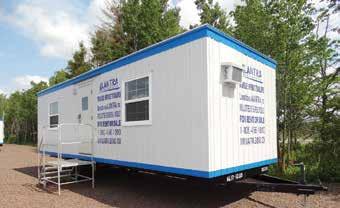
12 minute read
CANB member benefits
Do you know all the benefits of being a member of the Construction Association of New Brunswick (CANB)? Of course there’s the obvious – project information available 24/7, which includes the online and physical plans room – but did you know that being a member of the CANB also means your company: • Is included in CANB’s membership directory. • Receives discounts at hotels in the Atlantic provinces,
Mark’s, and Deluxe Business Products. • Receives a member rate on Bid Depository forms. • Has use of large training/meeting facilities at memberdiscounted rates.
And that’s not all. There are things going on behind the scenes too.
• Advocacy – membership in the association allows you to have a voice in making the views of the constructionrelated issues to governments, legislators, and the media and the public. • Networking – CANB hosts numerous social functions throughout the year, such as dinner meetings, curling, and golf events. These events provide members with endless networking opportunities.
• Education – the CANB sponsors a number of informative education programs through seminars or dinner meetings. Topics covered include construction law, construction document reading, estimating, and job planning.
• Labour relations – The association is the accredited employer’s organization under the New Brunswick
Industrial Relations Act and bargains on behalf of its certified members with both the Labourers International
Union of North America and the United Brotherhood of
Carpenters and Joiners of America.
Sustainability isn’t a trend. It’s the future of refrigeration.
If 2020 has taught us anything, it’s that we’re in this together. At CIMCO we know that when it comes to fighting climate change, we’re in that together too. As leaders in sustainable refrigeration, CIMCO can help you navigate this important transition. From our signature green technology that’s cost-effective and built-to-last, to our innovative range of customizable and energy-efficient options, we have the tools and expertise you need to reach net-zero emissions.
Let’s fight climate change together.
Dartmouth, NS 902-469-6642 St. Johns, NL 709-753-1440 Moncton, NB 506-854-7787 cimcorefrigeration.com

APPRENTICESHIP APPRENTISSAGE

Toll Free No.: 1-855-453-2260
No sans frais: 1-855-453-2260
Apprenticeship is a long-standing part of the training and education system in New Brunswick. It is a structured training program that requires the committed participation of three partners: the apprentice, the employer and the government represented by Apprenticeship and Occupational Certification.
The required hours of training for each occupation are defined by regulation under the Apprenticeship and Occupational Certification Act. About 80% of the apprentice’s training is done on-the-job at the employer’s place of business where the apprentice performs progressively challenging prescribed tasks under the supervision of a journeyperson. The remaining 20% involves technical (in-school) training at a post-secondary training establishment. This training is usually provided by the NB Community Colleges under the guidance of qualified instructors. A Progress Record Book identifies the tasks that must be performed on the job by the apprentice and records the progress of the apprentice through the apprenticeship program.
Upon the successful completion of an apprenticeship program, the completing apprentice will be issued a Diploma of Apprenticeship, a Certificate of Qualification, and in some cases, an Interprovincial Red Seal, all signifying journerperson status.
For replacement of marks, transcripts, Diploma of Apprenticeship, Certificate of Qualification and Identification pocket cards, please contact your Regional Apprenticeship and Occupational Certification office. L’apprentissage fait depuis longtemps partie intégrante et essentielle du système d’éducation et de formation au Nouveau-Brunswick. C’est un programme d’éducation structuré qui requiert la participation de trois partenaires: l’apprenti, l’employeur et le gouvernement qui est représenté par l’Apprentissage et certification professionnelle.
Les heures exigées pour chaque profession sont définies par le règlement sous la Loi sur l’apprentissage et la certification professionnelle. Environ 80% de la formation d’un apprenti a lieu en cours d’emploi. Cette formation pratique se déroule chez l’employeur où l’apprenti accompli des tâches réglementaires de complexité progressive sous la supervision d’un compagnon. L’autre 20% comprend la formation technique dans un établissement post-secondaire. La formation technique est habituellement enseignée par des instructeurs qualifiés des collèges communautaires du Nouveau-Brunswick. Un livret de contrôle identifie les tâches pré-établies que les apprentis doivent accomplir en cours d’emploi et fait état de l’évolution des compétences acquises par l’apprenti au programme d’apprentissage.
Après avoir satisfait à toutes les exigences du programme d’apprentissage, l’apprenti se verra décerner un diplôme d’apprentissage, un certificat d’aptitude, et dans certains cas, le Sceau rouge interprovincial, tous reconnus comme statut de compagnon.
Pour obtenir une copie d’un relevé de notes, diplôme d’apprentissage, certificat d’aptitude et une carte d’identité, veuillez s’il vous plaît contacter votre bureau régional d’apprentissage et certification professionnelle.
CONSTRUCTION OUTLOOK FOR NEW BRUNSWICK –2021 TO 2030
By Bill Ferreira, executive director of BuildForce Canada
There is no disputing it, 2020 was a very difficult year for Canadians. What started out as another promising year, quickly turned into a year of great uncertainty as provincial lockdowns spread across the country to contain COVID-19. For most of us, 12:00 a.m. New Year’s Day simply couldn’t come soon enough.
New Brunswick was most certainly not immune. COVID-19 had a devastating impact on the province’s commercialsector businesses. It also created supply chain challenges, as lockdown restrictions across the country were lifted. The net impact of these disruptions on the province’s construction labour force was minor, though overall employment was down 3.2 per cent for the year, driving the annualized unemployment rate up from 15.8 per cent in 2019 to 16.8 per cent in 2020. While the promise of mass vaccinations against the virus should bring on stronger growth in 2021, such growth is likely to remain elusive until the latter half of the year.
In our most recent outlook for the construction and maintenance industry in New Brunswick, BuildForce expects stable levels of activity throughout the decade, with growth in the residential sector largely offsetting declines in non-residential construction, but for a modest rise toward the end of the decade related to the rehabilitation of the Mactaquac Dam in the central part of the province. Figure 1 shows construction employment by residential, nonresidential, and total industry employment across the decade.
Figure 1: Construction industry employment growth (2021–2030), New Brunswick
Growth in the residential sector will be largely driven by increasing demand for renovation and maintenancerelated construction. With an aging stock of housing and increasing migration to the province expected, employment in the renovation and maintenance sectors will grow throughout the decade, rising by 11 per cent and nine per cent, respectively. By 2030, overall residential construction employment should be four per cent higher than levels recorded in 2020. Figure 2 illustrates the overall change in the estimated population for the province over the decade, tracking both the impacts of natural population growth and migration to New Brunswick.

Figure 2: Population growth trends, New Brunswick

* Natural rate of population growth refers to the growth in the population due to the number of births relative to the number of deaths, which leads to a positive or negative natural rate.
While increased provincial migration is expected to keep residential construction employment growing modestly throughout the decade, the completion of several civil and institutional infrastructure projects, in contrast, will reduce demand for non-residential employment in the near term, though heavy-industrial maintenance requirements may create seasonal recruitment challenges for some specific trades. The net impact of these two diverging trends will be less than one per cent overall employment growth throughout the decade.
In our latest outlook, BuildForce estimates that nearly 3,000 residential and nearly 4,000 non-residential workers will exit the labour force between 2021 and 2030 due to retirement. And while we estimate during this period the industry will successfully recruit 4,300 new entrants through traditional local recruitment and development initiatives, a gap of some
2,600 workers is expected to emerge. This means that, to keep pace with construction demands and to replace retiring workers, the industry will need to recruit and retain approximately 6,500 new workers over the course of the decade.
Recruitment into the construction and maintenance sector is not a simple process and is not always driven by the province’s apprenticeship system. However, for most industrial, commercial, and institutional projects, apprentices make up the majority of the labour force. As such, apprenticeship development rates in the province can often be a bellwether for overall industry recruitment success.
According to the latest Statistics Canada Registered Apprenticeship Information System (RAIS), apprenticeship registrations declined from 2015 to 2016, but then grew to 2018 in almost all the major construction trade programs. However, in 2019, registrations in all but the carpentry and heat and frost program declined. Figure 3 shows registrations in the province’s 10 largest apprenticeship programs over the past five years.
Though registrations fluctuate based on construction demands, so too does the length of time it takes for an apprentice to complete their program. Based on the latest cohort study by Statistics Canada, we see that it takes roughly six years for the majority of apprentices to complete their program. While rates vary between trades, Table 1 shows program certifications, continuation, and discontinuations for the 2012 cohort.

To keep pace with construction demands and retirements, the industry will need to remain focused on labour force development over the coming decade. BuildForce estimated the gap between retirements and new entrants in 2020 at 318 workers. If not addressed, this annual gap will amount to a shortfall of nearly 2,600 workers by 2030. Based on our analysis of registrations, completions, and the estimated departures (retirement and exits to other industries) of existing Certificate of Qualification holders from the industry, several trades were identified as being at risk of undertraining over the decade in order to keep pace with estimated demands. These are boilermaker, bricklayer, carpenter, hoist operator, sheet metal worker, sprinkler fitter, and welder.
Building a sustainable and diverse labour force will also require the construction and maintenance industry to expand its recruitment efforts to groups that have traditionally been underrepresented in the industry.
Table 1: Apprenticeship development rates for the 2012 cohort, New Brunswick
Selected trades Cohort size Program Median age at Within 1.5 times program duration 2012 duration registration Certification Continuation Discontinuation
Carpenter Construction Electrician 120 4
215 4 Heavy-Duty Equipment Technician 25 4 Millwright 45 4
Plumber 90 4
Heat and Frost Mechanic 35 4
Sheet Metal Worker Steamfitter/Pipefitter Welder 25 4
25 4
40 3 24
24
21
27
24
26
24
34
22 36.0%
46.5%
40.0%
77.8%
44.4%
66.7%
60.0%
40.0%
44.4% 16.0% 48.0%
23.3% 30.2%
0.0%
11.1% 60.0%
11.1%
22.2% 33.3%
0.0% 33.3%
20.0% 20.0%
20.0% 40.0%
11.1% 44.4%
Source: Statistics Canada. Table 37-10-0193-01 Certification, continuation and discontinuation rates of newly registered apprentices within program duration, 1.5 times program duration and 2 times program duration
Women have traditionally made up a small share of the overall construction labour force. In 2020, there were approximately 2,100 women working in the provincial industry, with about 640 (30 per cent) of those working on site, and 1,460 (70 per cent) working in off-site professions. As a share of the overall labour force, the 640 women working on site represented just three per cent of the total on-site workforce. The numbers are significantly better, however, when representation is measured in off-site professions. The 1,460 women working in off-site professions accounted for approximately 37 per cent of the total off-site workforce, which is still below their overall 48 per cent share of the total provincial labour force. Clearly increasing the recruitment of women to the construction labour force will go a long way to addressing the industry’s long-term labour force development needs. But it is not just women.
Considerable recruitment potential exists with other nontraditional groups. Indigenous people, for one, represent approximately five per cent of the region’s total labour force; however, they make up only 2.7 per cent of the province’s construction labour force. With about 79 per cent of the industry’s Indigenous workers active in on-site construction, there could be further scope to increase the participation of Indigenous people in the construction trades. Newcomers to Canada also present significant recruitment opportunities for the industry. As a share of the provincial labour force, newcomers make up 6.6 per cent of the total, while in the construction industry they account for only two per cent of the industry’s labour force. With the province hoping to increase immigration levels to 6,800 newcomers annually over the next decade, focused recruitment campaigns could significantly increase the participation of newcomers in the construction and maintenance industry.
Increasing recruitment from all three of these groups could help close any recruitment gap over the decade created by increased retirement levels.
In short, while changing population and industry demographics will create added labour force development challenges, with more stable construction demands expected throughout the decade, the opportunities for increased training that come from rising demand growth will be limited. With nearly 29 per cent of the existing construction and maintenance industry expected to retire by 2030, focused industry attention will be required to ensure the construction and maintenance labour force remains adequate to meet the future needs of the province’s economy.
Purpose:
“Build and Unit”: Create a win-win relationship with our customers through our team
Vision:
To propel the mechanical industry forward
Mission:
We systematically deliver the right mechanical solution for our customers by understanding their needs.
5 Rousseau Avenue Edmundston, NB E3V 4H4
Residential
Heat Pump (Mini Split), Plumbing Service and Ventilation
Multi Residential
Commercial
Plumbing, Heating, Ventilation, Refrigeration, Propane, and Food Equipment Repair
Institutional
Industrial
Beaulieu Plumbing & Mechanical Phone : 506-739-2030 | www.beaulieumech.ca

Serving Eastern Canada Rent, Lease, Purchase.
MOBILE OFFICE TRAILERS • MODULAR BUILDINGS
• O ce Trailers/Complexes • Lunchrooms/ Classrooms • Self-Contained Washroom Trailers • Construction Camps • Custom Modular Buildings • Mining/Drilling Facilities • Sea Cans / Shipping Containers

If we don’t have it, we can build it!
FIRE & LIFE SAFETY SOLUTIONS
Vipond has been providing fire detection, suppression and fire sprinkler systems to a variety of industries since 1945. We design, install, test, inspect and service all types of systems.
INTEGRATED SECURITY SOLUTIONS
• Access Control, CCTV • Education Communications • Nurse Call, Clocks • Intercoms, Public Address • Intrusion • Gate Control Systems
FIRE SUPPRESSION SYSTEMS
• Wet Fire Sprinkler Systems • Dry Fire Sprinkler Systems • Pre-Action Fire Sprinkler Systems • Fire Extinguishers • Foam Systems • Sprinkler System Monitoring
FIRE DETECTION SYSTEMS
• Notifier Fire Alarm Systems • Optical Flame Detection • Aspirated Air Sampling Detection • Linear Heat Detection • Fire Alarm & Elevator Monitoring • ULC Certified
SPECIAL HAZARDS SYSTEMS
• Clean Agents (NOVEC 1230, FM 200, FE-13) • Inert Gases ( Argonite, Nitrogen) • Carbon Dioxide Systems • Gas Detection • Hybrid Systems (Vortex) • Dry Chemical Systems
alantraleasing.com alantraleasing.com 1-800-456-1800 1-800-456-1800 CALL US TODAY! CALL US TODAY!
ALARM & SOUND
309 English Drive, Moncton, NB E1E 3Y8
Phone: 506-857-8505










